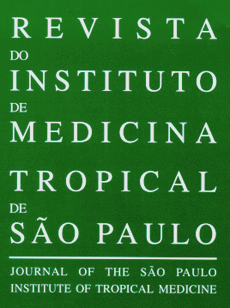In Brazil, more than 500,000 new cases of malaria were notified in 1992. Plasmodium falciparum and P.vivax are the responsible species for 99.3% of the cases. For adequate treatment, precoce diagnosis is necessary. In this work, we present the results of the traditional Plasmodia detection method, thick blood film (TBF), and the results of alternative methods: Immunofluorescence assay (IFA) with polyclonal antibody and Quantitative Buffy Coat method (QBC)® in a well defined population groups. The analysis were done in relation to the presence or absence of malaria clinical symptoms. Also different classes of immunoglobulins anti-P.falciparum were quantified for the global analysis of the results, mainly in the discrepant results. We concluded that alternative methods are more sensitive than TBF and that the association of epidemiological, clinical and laboratory findings is necessary to define the presence of malaria.
Malaria; Plasmodia detection; diagnosis; IFA; QBC
